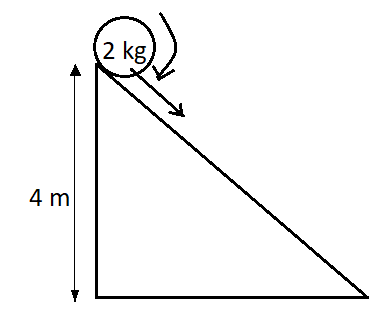
A solid cylinder rolls down an incline plane. Its mass is 2 kg and radius 0.1 m. If the height of the inclined plane is 4 m, its rotational kinetic energy, when it reaches the foot of the plane is:
(A) 78.4 J
(B) 39.2 J
(C) $\dfrac{78.4}{3}$ J
(D) 19.6 J
Answer
516.9k+ views
Hint: The sum of translational and rotational kinetic energy of the cylinder will give the total kinetic energy of the cylinder at the bottom of the incline. This energy is taken from the potential energy that it stored in the cylinder at a height of 4 m.
Formula used:
The loss in potential energy turns into to the gain in kinetic energy at the bottom of the incline:
Loss in P.E. = Gain in K.E.
In rotational motion, the angular velocity of motion is written as:
$v = r \omega $
Rotational kinetic energy is given as:
$R.K.E. = \dfrac{1}{2}I \omega^2 $
Complete answer:
Let the mass of the cylinder be denoted by m, the radius be denoted by r and the moment of inertia be denoted by I.

The total kinetic energy for the cylinder is written as:
$K.E. = \dfrac{1}{2}mv^2 + \dfrac{1}{2}I \omega^2$
We know that for the case of cylinder the moment of inertia is written as:
$I = \dfrac{1}{2}MR^2$ .
Substituting this in the kinetic energy expression, we get:
$K.E. = \dfrac{1}{2}mv^2 + \dfrac{1}{2} \left( \dfrac{1}{2}mr^2\right) \omega^2$.
Now, we also substitute the frequency of rotational motion of the cylinder here:
$K.E. = \dfrac{1}{2}mv^2 + \dfrac{1}{4} \left( mr^2\right) \left( \dfrac{v}{r} \right)^2 = \dfrac{3}{4}mv^2$ .
The potential energy at the top of h height is written as:
P.E. = mgh.
Equating this with the obtained potential energy we get:
$mgh = \dfrac{3}{4}mv^2$.
The velocity is obtained from this expression as:
$v = \sqrt{\dfrac{4gh}{3}}$.
The rotational kinetic energy is:
$\dfrac{1}{2}I \omega^2 = \dfrac{1}{4} m v^2$
where substitution for I and angular velocity has been made.
Keeping the value of v in this expression, we get rotational kinetic energy as:
$R.K.E. = \dfrac{mgh}{3} = \dfrac{2 \times 9.8 \times 4}{3} = \dfrac{78.4}{3} $ J.
Note:
The value of g has been kept as 9.8 instead of 10 m/s$^2$. In performing rotational motion, if the centre of mass of the cylinder translates with a velocity v then the entire cylinder moves with the same velocity and the rotational velocity of its outer rim is related to the translational velocity.
Formula used:
The loss in potential energy turns into to the gain in kinetic energy at the bottom of the incline:
Loss in P.E. = Gain in K.E.
In rotational motion, the angular velocity of motion is written as:
$v = r \omega $
Rotational kinetic energy is given as:
$R.K.E. = \dfrac{1}{2}I \omega^2 $
Complete answer:
Let the mass of the cylinder be denoted by m, the radius be denoted by r and the moment of inertia be denoted by I.

The total kinetic energy for the cylinder is written as:
$K.E. = \dfrac{1}{2}mv^2 + \dfrac{1}{2}I \omega^2$
We know that for the case of cylinder the moment of inertia is written as:
$I = \dfrac{1}{2}MR^2$ .
Substituting this in the kinetic energy expression, we get:
$K.E. = \dfrac{1}{2}mv^2 + \dfrac{1}{2} \left( \dfrac{1}{2}mr^2\right) \omega^2$.
Now, we also substitute the frequency of rotational motion of the cylinder here:
$K.E. = \dfrac{1}{2}mv^2 + \dfrac{1}{4} \left( mr^2\right) \left( \dfrac{v}{r} \right)^2 = \dfrac{3}{4}mv^2$ .
The potential energy at the top of h height is written as:
P.E. = mgh.
Equating this with the obtained potential energy we get:
$mgh = \dfrac{3}{4}mv^2$.
The velocity is obtained from this expression as:
$v = \sqrt{\dfrac{4gh}{3}}$.
The rotational kinetic energy is:
$\dfrac{1}{2}I \omega^2 = \dfrac{1}{4} m v^2$
where substitution for I and angular velocity has been made.
Keeping the value of v in this expression, we get rotational kinetic energy as:
$R.K.E. = \dfrac{mgh}{3} = \dfrac{2 \times 9.8 \times 4}{3} = \dfrac{78.4}{3} $ J.
Note:
The value of g has been kept as 9.8 instead of 10 m/s$^2$. In performing rotational motion, if the centre of mass of the cylinder translates with a velocity v then the entire cylinder moves with the same velocity and the rotational velocity of its outer rim is related to the translational velocity.
Recently Updated Pages
Master Class 12 Business Studies: Engaging Questions & Answers for Success

Master Class 12 Economics: Engaging Questions & Answers for Success

Master Class 12 English: Engaging Questions & Answers for Success

Master Class 12 Maths: Engaging Questions & Answers for Success

Master Class 12 Social Science: Engaging Questions & Answers for Success

Master Class 12 Chemistry: Engaging Questions & Answers for Success

Trending doubts
What is meant by exothermic and endothermic reactions class 11 chemistry CBSE

Which animal has three hearts class 11 biology CBSE

10 examples of friction in our daily life

One Metric ton is equal to kg A 10000 B 1000 C 100 class 11 physics CBSE

1 Quintal is equal to a 110 kg b 10 kg c 100kg d 1000 class 11 physics CBSE

Difference Between Prokaryotic Cells and Eukaryotic Cells




